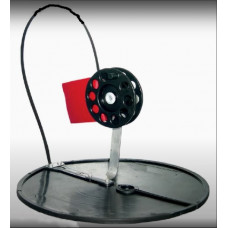Fishing rod is a tackle for fishing for predatory fish. It consists of a double hook and a long fishing line, which is reeled on a spool, circle or horn. A live fish is put on the hook.
For summer and winter fishing there are respectively summer and winter fishing poles. The floating variant of the summer fishing rod is the "Fishing circle".
The shore summer fishing line consists of a fishing line (cord) wound crosswise on a small wooden rod (a forked twig), tied to a hexagon stuck obliquely to the water. You can use a reel instead of a rogulka. To the fishing line, on a leash, a hook is tied (usually used double or treble), baited with a bait, and lowered into the water. The predator, grabbing the bait, pulls the fishing line, which is gradually reeled off the reel. Having swallowed the bait together with the hook, the fish is caught, and then pulled out by fishermen in the periodic inspection of their put them rigging. It is used mainly for catching pike, but can also be used for catching catfish, burbot, zander, chub and other fish species. From a boat, a fishing circle is usually used.
The most widespread is fishing on winter fishing poles. For winter fishing the camouflage of the tackle is of special importance - the fishing line should be painted to match the color of the water, the hook is white, and it is pressed to the body of the animal with a rubber ring. There is a distinction between above-ice and below-ice fishing lines.
There are many designs of winter fishing poles. The simplest winter fishing rod is made on the basis of a small rod, which is installed near the hole. A fishing line is tied to the rod, and a piece of rag, twig, etc. serves as a nibble indicator. A more complex design of a fishing rod consists of a reel holder, a reel with a fishing line wound on it, and a signaling device with a flag. The rod is installed on top of the hole. A fishing line with a leash and a hook at the end is wound on the spool. On the hook is hooked bait, and lowered into the hole. The flag is tucked under the spool so that the spool does not allow it to stand upright. When the predator grabs the bait and pulls the line, the spool begins to rotate and the flag pops out and takes a vertical position. The fisherman, seeing the triggered flag, runs to the reel and hooks the predator, so that the hook is firmly planted in his jaw. It is used for catching pike, pikeperch and other fish species.
On rivers with fast currents, you can set up a float rod. A heavy sinker is placed on the bottom, a float with a small carrying capacity is under water (hidden under the ice so that it does not freeze), signaling a nibble.
The winter fishing rod with an ice fishing line does not have a nibble indicator in its design. It is a passive method of fishing. The line spreader (e.g. a wooden rod with a cleft) with the coiled main line is lowered under the ice. Places of installation of the fishing rod are marked with a rod. Most often this method is used to catch burbot, the fishing poles are set for the night and checked in the morning. The advantage of this type of fishing rod is that the stock of fishing line on the fishing line will not freeze, and, therefore, the fishing rod, regardless of snow, rain, etc. will always be in "combat readiness". The disadvantage is the lack of nibble signaling.
Zherlitsa
Tags: zherlitsa

